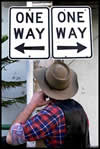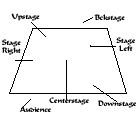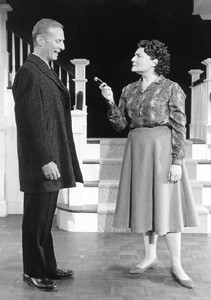|
|
 
Unit
4- Script and Play Analysis
Module
1 - Play Structure
Lesson
3 - Stage Directions
Objectives:
- to block improvised or scripted scenes
- (to understand and execute stage
movement effectively) not a curriculum objective
-
to
cooperate with others
Resources:
Movement Handout, Dance
Evaluation(pdf)
CELs:
C, CCT
Components:
Creative, Productive
|
 |
Introduction:
Directions
are a basic part of traffic flow in all parts of life. On
the stage there are specific names for locations and symbols
that are used to help people keep their positions. Sometimes
the directions can be confusing because right, left, up
and down are absolutes. This means stage left might be your
right!
|
 |
|
|
Activities:
Background
Infromation:
Each of the labeled directions represents a part of the stage.
The area closest to the audience at the front of the stage
is called downstage. The area farthest from the audience is
upstage. These terms originate from historical stages that
were raked. The front of the stage was literally lower or
father down than the back, so that the audience could see
all parts of the stage even without tiered seating.
The terms
stage right and left refer to the actor's right and left when
on stage. If you sitting with a director who called out "Stage
Left, please", you would see the actor move to your right.
The movie below demonstrates the stage directions:
|
 |
|
|
|
|
|

This
photo is provided with permission by Trinity. It is
a picture from David Mamet's The Cryptogram.
|
 |
Cheating
out is used by actors to help the audience see more of
a character. In real life, the man and woman would stand
directly facing each other. In a play, they would do as
the woman has - "cheat" by turning her body
towards the audience. |
|
Activity
One:
In groups of three or four, students read the
movement handout. They develop a short action sequence
(with lines). One person in the group directs the action
and the other students are characters. Each group uses
the checklist on the handout to check all the movements
they have created. The groups present to the class.
Activity
Two:
Instructions for this assignment are found in the movement
handout. Students work in groups of two to five and
create a brief dance to music. Evaluation is based primarily
on variety of movements, use of time and how students
work together.
|
|
|
Instructional
Strategies: role play, problem solving
Evaluation:
Informal evaluation of presentation in class. Formal evaluation
of the dance projects, in pdf.
On-line
Alternative: Assignments can be done with partners within
the school of origin, then e-mailed as video attachments.
Video tapes may also be sent via the mail.
Next
Lesson / Student
Lesson / Previous Lesson
|
|
|











